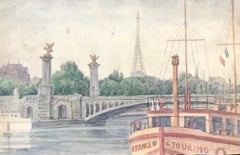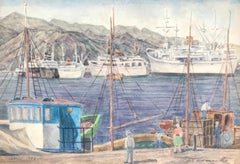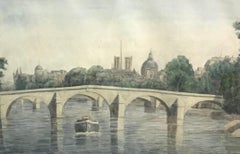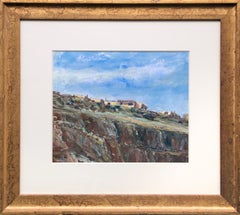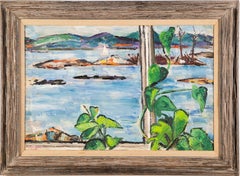Pierre Desaules Paintings
Swiss, 1906-1973
Neuchatel painter.
Pierre Desaules was an artist. Pierre Desaules was born in 1906 and died in 1973.
Artists like Jacques Abeille, Donald Lester Dickson, Mario Borgiotti, Renzo Agostini, and Artur Carbonell Carbonell were also born in 1906.to
4
4
Overall Width
to
Overall Height
to
4
3
1
4
4
2
2
1
1
1
1
1
1
1
1
4
4
2
5
781
717
705
691
2
3
4
Artist: Pierre Desaules
Port de Mallorca, Palma by Pierre Desaules - Gouache on paper 29x44 cm
By Pierre Desaules
Located in Geneva, CH
Work on paper
Brown wooden frame with glass pane
51,5 x 66 x 3,5 cm
Category
1950s Modern Pierre Desaules Paintings
Materials
Gouache
Alexander III Bridge, Paris by Pierre Desaules - Watercolor on paper 30x45 cm
By Pierre Desaules
Located in Geneva, CH
Work on paper
Category
1980s Modern Pierre Desaules Paintings
Materials
Watercolor
Ocean liners, Santa Cruz of Tenerife by Pierre Desaules - Gouache on paper 30x44
By Pierre Desaules
Located in Geneva, CH
Work on paper
Category
1950s Modern Pierre Desaules Paintings
Materials
Gouache
Royal bridge, Paris by Pierre Desaules - Watercolor on paper 29x44 cm
By Pierre Desaules
Located in Geneva, CH
Work on paper
Golden wooden frame with glass pane
51,5 x 66 x 4 cm
Category
1950s Modern Pierre Desaules Paintings
Materials
Watercolor
Related Items
1970s Acoma Pueblo, New Mexico Southwest Landscape Gouache Painting, Signed Art
Located in Denver, CO
This stunning gouache painting by Wolfgang Pogzeba (1936-1982) captures the beauty of Acoma Pueblo, New Mexico, depicting a dramatic cliffside landsca...
Category
1970s American Modern Pierre Desaules Paintings
Materials
Gouache
$2,063 Sale Price
24% Off
H 22.38 in W 25 in
Antique American Modernist Nature Study Lake Landscape Framed Oil Painting
Located in Buffalo, NY
Antique American modernist landscape oil painting. Oil on canvas, circa 1940. Signed illegibly lower left. Image size, 36L x 24H. Housed in a period modern frame.
Category
1940s Modern Pierre Desaules Paintings
Materials
Canvas, Oil, Gouache
$796 Sale Price
20% Off
H 33 in W 45 in D 2 in
Antique American Hudson River School Framed Landscape Signed Original Painting
Located in Buffalo, NY
Antique Hudson River School landscape painting by William Louis Sonntag, Sr. (1822 - 1900). Watercolor and gouache on board. Framed. Signed. Measuring: 13 by 17 inches overall, and ...
Category
1870s Modern Pierre Desaules Paintings
Materials
Watercolor, Gouache, Board
$1,180 Sale Price
20% Off
H 19 in W 25 in D 2 in
Antique American Modernist Chickens Grazing Bucolic Landscape Framed Painting
Located in Buffalo, NY
Antique American modernist painting. Watercolor and gouache on paper. Framed. Signed. In excellent original condition. Handsomely framed in a modern molding. Excellent condition, ...
Category
1950s Modern Pierre Desaules Paintings
Materials
Watercolor, Gouache, Archival Paper
$780 Sale Price
20% Off
H 23 in W 26 in D 2 in
A Charming 1940s Watercolor of Mexico w/ Cathedral and Rooftops by Rudolph Pen
Located in Chicago, IL
A Charming 1940s Watercolor of Mexico with Cathedral and Rooftops by Noted Chicago Artist, Rudolph T. Pen. Most likely completed during the artist's trip to Mexico in 1944 after rec...
Category
1940s American Modern Pierre Desaules Paintings
Materials
Paper, Watercolor, Gouache
$1,200
H 12 in W 22.5 in D 0.13 in
Antique American Modernist Wild Horses Western Landscape Watercolor Painting
Located in Buffalo, NY
Very finely painted modernist landscape by Robert Noel Blair (1912 - 2002). Watercolor and gouache on paper. Signed Image size, 22 by 30 inches. In excellent original condition. ...
Category
1950s Modern Pierre Desaules Paintings
Materials
Watercolor, Archival Paper
$1,340 Sale Price
20% Off
H 29 in W 36 in D 2 in
Antique American Modernist Abstract Framed Landscape Watercolor Painting
Located in Buffalo, NY
Very finely painted modernist landscape by Robert Noel Blair (1912 - 2002). Watercolor and gouache on paper. Signed Image size, 23 by 31 inches. In excellent original condition. ...
Category
1950s Modern Pierre Desaules Paintings
Materials
Watercolor, Archival Paper
$1,340 Sale Price
20% Off
H 27 in W 34 in D 2 in
Antique Israeli American Folk Art Modernist Figural Landscape Framed Painting
Located in Buffalo, NY
Antique Israeli American modernist folk art landscape by Malcah Zeldis. Mixed media painting on paper. Framed. Signed. Measuring 18 by 22 inches overall and 11 by 14 painting alone....
Category
1960s Modern Pierre Desaules Paintings
Materials
Board, Watercolor, Archival Paper
$796 Sale Price
20% Off
H 18 in W 22 in D 2 in
"Union Square" NYC American Scene Social Realism Modernism WPA Mid-20th Century
By Agnes Hart
Located in New York, NY
"Union Square" NYC American Scene Social Realism Modernism WPA Mid-20th Century
Agnes Hart (American, 1912-1979)
"Union Square, New York City"
Sight: 14 1/2 x 21 1/2 inches
Gouache...
Category
1940s American Modern Pierre Desaules Paintings
Materials
Gouache, Board
Antique American Modernist Abstract Framed Lake Erie Summer Seascape Painting
Located in Buffalo, NY
Very finely painted modernist landscape by Robert Noel Blair (1912 - 2002). Watercolor and gouache on paper. Signed Image size, 22 by 29 inches. In excellent original condition. ...
Category
1950s Modern Pierre Desaules Paintings
Materials
Watercolor, Archival Paper
Robert Noel BlairAntique American Modernist Abstract Framed Lake Erie Summer Seascape Painting, 1960
$1,340 Sale Price
20% Off
H 27 in W 35 in D 2 in
Large Vintage American Modernist Horse Barn Landscape Framed Equestrian Painting
Located in Buffalo, NY
Antique French American modernist horse barn painting. Mixed media painting on paper. Framed. Signed. Measuring 41 by 49 inches overall and 31.5 by 39.5 painting alone. In excellent ...
Category
1950s Modern Pierre Desaules Paintings
Materials
Board, Watercolor, Gouache
$14,200 Sale Price
62% Off
H 41 in W 49 in D 2 in
1950s "Mound Street" Mid Century Figurative Painting American Modernist
By Donald Stacy
Located in Arp, TX
Donald Stacy
"Mound Street"
c. 1950s
Gouache paint on paper
24" x 18'" unframed
Unsigned
Came from artist's estate
For sale is a striking black and white painting titled "Mound Stre...
Category
Mid-20th Century American Modern Pierre Desaules Paintings
Materials
Paper, Gouache
$570 Sale Price
40% Off
H 18 in W 24 in
Previously Available Items
Rhône Valley by Pierre Desaules - Gouache on paper 27x43 cm
By Pierre Desaules
Located in Geneva, CH
Work on paper
Category
1930s Modern Pierre Desaules Paintings
Materials
Gouache
H 10.87 in W 17.01 in D 0.04 in
Pierre Desaules paintings for sale on 1stDibs.
Find a wide variety of authentic Pierre Desaules paintings available for sale on 1stDibs. You can also browse by medium to find art by Pierre Desaules in paint, watercolor, gouache and more. Much of the original work by this artist or collective was created during the 20th century and is mostly associated with the modern style. Not every interior allows for large Pierre Desaules paintings, so small editions measuring 18 inches across are available. Pierre Desaules paintings prices can differ depending upon medium, time period and other attributes. On 1stDibs, the price for these items starts at $110 and tops out at $660, while the average work can sell for $165.
